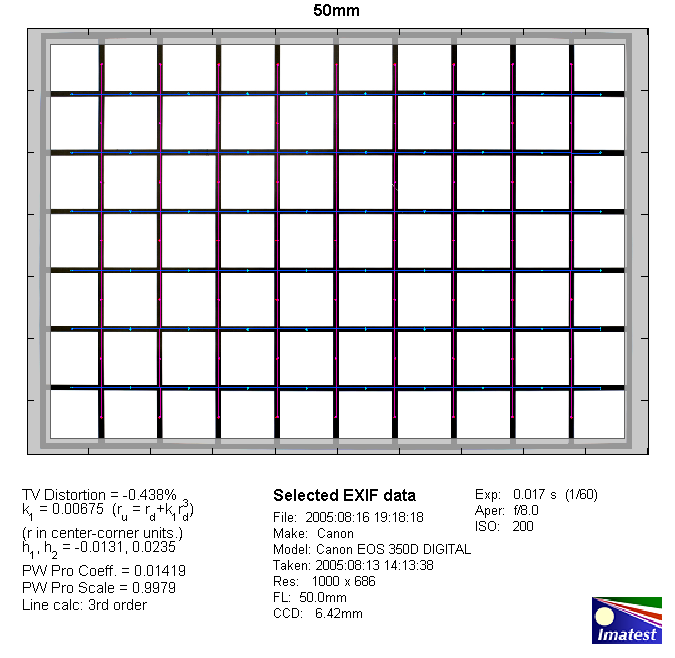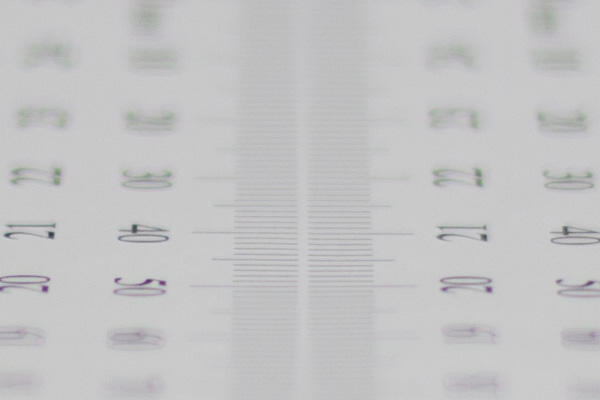|
Canon EF 50mm f/1.4 USM - APS-C Review / Retest - Analysis |
|
Lens Reviews -
Canon EOS (APS-C)
|
|
Page 2 of 2

Distortion
The EF 50mm f/1.4 produces a slight amount of barrel distortion (0.4%). This is pretty much negligible in field conditions.
 Note: we reused the distortion results from our initial test. This characteristic cannot change when moving to a higher mega-pixel body.
Note: we reused the distortion results from our initial test. This characteristic cannot change when moving to a higher mega-pixel body.
Vignetting
Usually there's only a minimal amount of light fall-off when using a full format lens on an APS-C DSLR. However, the EF 50mm f/1.4 USM is a bit of an exception to the rule here because it produces a significant vignetting at max. aperture. At ~1EV (f-stops) this will be visible in field images here. The issue is basically gone from f/2 onwards.

MTF (resolution)
The resolution characteristic of the Canon lens is somewhat mixed. The image center is already very good at f/1.4 but the borders are quite soft. This is a difference compared to our initial test and possibly the result of a slight centering issue that we've seen in the tested sample. The overall contrast is also rather mediocre at this setting. The situation changes when stopping down to f/2 already. The border quality is lifted to good levels and the overall contrast improves as well. The quality reaches quite breathtaking levels from f/2.8 to f/8. It's quite safe to assume that the lens outperforms the 15mp sensor of the base DSLR here.
Please note that the MTF results are not directly comparable across the different systems!
Below is a simplified summary of the formal findings. The chart shows line widths per picture height (LW/PH) which can be taken as a measure for sharpness.
If you want to know more about the MTF50 figures you may check out the corresponding Imatest Explanations
Chromatic Aberrations (CAs)
Similar to most other fix-focal lenses chromatic aberrations (color shadows at harsh contrast transitions) are
very low and nothing to worry about.

Bokeh
The bokeh (the quality of the out-of-focus blur) is a primary aspect for an ultra large aperture lens. Out-of-focus highlights are basically circular when used on an APS-C DSLR (as opposed to the cat's eye effect @ f/1.4 when used on full format DSLRs). There's an outlining effect but the inner highlight zone is very smooth and uniform. The outlining is slightly improved at f/2 and it's gone by f/2.8. However, starting at f/2.8 the highlights are no longer circular (thus the aperture is not circular anymore). The quality of the blur in the critical focus transition zones is very smooth.

Bokeh Fringing / Longitudinal Chromatic Aberrations (LoCA)
Bokeh fringing is a common problem present in most large aperture lenses and the Canon lens is no
exception to the rule here. If you look at the provided sample crops below you should be able to spot
a purple halo in front of the focus zone and a green one beyond. This is clearly visible at f/1.4 till
f/2. The problem starts to fade at f/2.8 and it's resolved at f/5.6.
|
Move the mouse cursor over the f-stop marks below to observe the respective LoCAs
|
| f/1.4 |
f/2 |
f/2.8 |
f/4 |
f/5.6 |
|

|
VerdictThe Canon EF 50mm f/1.4 USM is a rather obvious choice when looking for a standard lens to be used on an Canon APS-C DSLR. That said it struggles a bit at maximum aperture - the borders are somewhat soft here, the contrast level is reduced and the amount of vignetting could be better. However, the image quality is already quite impressive at f/2 and nothing short of outstanding in the f/2.8 to f/8 range. Lateral CAs are nothing to worry about. The bokeh is generally very good (within the APS-C scope it avoids some of the problems that we've seen in the corresponding full format test) but typical for such lenses there's quite a bit of bokeh fringing (LoCAs) at large apertures. The build quality on a decent level but it's not rock solid either. The micro-USM AF drive operates pretty fast and near silent.
| Optical Quality: |
 |
|
|
| Field Quality: |  (Low Light/Shallow Depth-of-Field Photography) (Low Light/Shallow Depth-of-Field Photography) |
| Mechanical Quality: |  |
| Price/Performance: |  |
| | |
| | What does this mean ? |
|